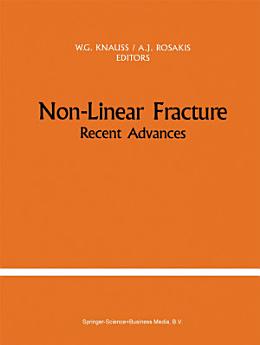Non-Linear Fracture: Recent Advances
W.G. Knauss · Ares J. Rosakis
mar 2013 · Springer Science & Business Media
eBook
404
Páginas
reportLas valoraciones y las reseñas no se verifican. Más información
Información sobre este eBook
From time to time the International Journal of Fracture has presented special matters thought to be of interest to its readers. In previous issues, for example, Dr. H.W. Liu as Guest Editor assembled a series of review papers dealing with fatigue processes and characteristics in metals and non-metals (December 1980 and April 1981). Five years ago Guest Editor W.G. Knauss collected works dealing with dynamic fracture (March and April 1985). Continuing this policy, Dr. W.G. Knauss and Dr. A.J. Rosakis of the California Institute of Technology as Guest Editors have now organized an extensive set of papers concerning the influence of non-linear effects upon the mechanics of the fracture process. This collection is based upon contributions to a relatively small international Symposium on Non Linear Fracture Mechanics held under the auspices of the International Union of Theoretical and Applied Mechanics (IUTAM) and convened at the California Institute of Technology in March 1988. It should be noted that although the description of non-linear fracture inherently encompasses a strong material science component, this aspect is not heavily emphasized in the ensuing papers due to the intentional focus upon mechanics. Volume 42 of the International Journal of Fracture will therefore, in successive issues, deal respectively with topics in (1) Damage, (2) Interfaces and Creep, (3) Time Dependence, and (4) Continuum Plasticity. On behalf of the editors and publishers, I wish to express our appreciation to Dr. Knauss, Dr. Rosakis, and their colleagues for their collective efforts.
Valorar este eBook
Danos tu opinión.
Información sobre cómo leer
Smartphones y tablets
Instala la aplicación Google Play Libros para Android y iPad/iPhone. Se sincroniza automáticamente con tu cuenta y te permite leer contenido online o sin conexión estés donde estés.
Ordenadores portátiles y de escritorio
Puedes usar el navegador web del ordenador para escuchar audiolibros que hayas comprado en Google Play.
eReaders y otros dispositivos
Para leer en dispositivos de tinta electrónica, como los lectores de libros electrónicos de Kobo, es necesario descargar un archivo y transferirlo al dispositivo. Sigue las instrucciones detalladas del Centro de Ayuda para transferir archivos a lectores de libros electrónicos compatibles.





